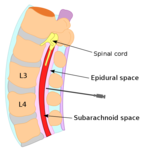Epidural Injection During Labor Side Effects
 In case of first pregnancy a pregnant woman wants to give birth to her child in a normal way without the aid of medicines. This may be due to underestimation of the extent of pain during labour. However as the time passes there is a change of mind and the woman on labour desires to get medication to reduce pain.
In case of first pregnancy a pregnant woman wants to give birth to her child in a normal way without the aid of medicines. This may be due to underestimation of the extent of pain during labour. However as the time passes there is a change of mind and the woman on labour desires to get medication to reduce pain.
How Epidural anesthesia is given ?
For pain control an epidural is the method employed. By inserting a small tube in the back of the woman in labor, a painkilling drug in injected around the nerves that carry signals of pain from that part of the body to the brain. This helps numbing the abdominal area and providing effective relief from pain. It is essential that epidurals should be administered by an expert anesthetist.
When the epidural is set up, the patient is made to lie down on the side or sit leaning forward to open up the space between bones and spine. With the help of a needle, a fine tube called catheter is placed in position near the layer of tissue which control the supply of information of pain to your brain.
Epidural injections can be given through the tube to numb the lower part of the body below the belly button. When this is done the patient does not feel the pain of contractions during childbirth. The effect generally lasts for two hours and if the labor continues beyond this time, a top up dose can be injected. The other method is by continuous infusion. A pump is attached to the catheter which continues to inject a calculated quantity of dose. Mostly low dose of pain relieving drug and anesthetic is given so that sensation remains in the lower part of the legs and feet. The drug is generally injected when the contractions become strong and fast and the cervix has opened up to 5 to 6 cms. and effect is continued till the baby is born. However a very mild dose may be continued even after the birth of the child to enable the mother to recover fully or after the stitches are given if needed.
Epidural injection during labor side effects & risks
Blood pressure drop: The major side effect of this drug is that in some cases it makes the blood pressure drop and may affect the supply of oxygen to the baby. In case a large dose is given, the breathing of the baby may be affected and he may become drowsy. However the major advantage is that the mother gets pain relief during labor and she remains aware of the contractions taking place. In case of patients with problem of hypertension, the blood pressure remains in control.
Long process: Another disadvantage of this system is that it takes about 20 minutes to set up the catheter tube and another 20 minutes for the medicine to act fully. If the lady decides to get an epidural after the start of labor, the relief comes quite late. Also in case of some women it may not provide adequate relief and numb only a part of the abdominal area, requiring readjustment of the tube and further injection of medicine.
Shivering: In certain cases shivering or itching could start and the woman may develop fever due to reaction of the medicine, after the injection of the drug. As such proper tests should be done before hospitalization, and instant decision to use this method should not be taken.
Numbness: Once the medicine is injected, the woman has to remain in bed as this affects the strength of the legs and feet and the woman cannot move around the bed as is sometimes recommended by the doctor to the woman in labour. The heartbeat of the baby and the mother should be properly monitored immediately after injection of the drug and after top up, and blood pressure should be continuously monitored. In some cases after the child birth a catheter may have to be inserted to clear the bladder as due to numbness caused by the drug the lady is unable to pass urine.
Headache: In the second stage of labor, when the baby has to be pushed the effort of the mother is minimal as due to no pain there is no urge. This may need the use of forceps to give birth to the child. After child birth when the effect of the drug starts to recede, some patients complaint of severe headache. This may require another injection of blood taken from the patient’s body into the spine to seal the leakage in the fluid bag around the spinal cord by the needle. However this is rare.
Even if you do not intend to use epidural during the child birth, it will be advisable to get the tests required by the anesthetist done well before the time of admission for delivery so that there are no last minute complications, in case you are unable to bear the pain and calls for pain relief.